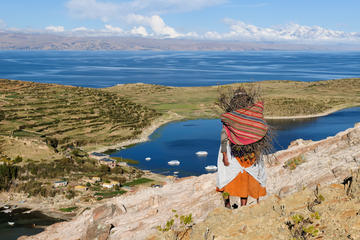
Lake Titicaca
Sweet, clear and a deep diaphanous blue, Lake Titicaca shimmers above South America at 3,812 meters (12,507 feet), the highest navigable lake in the world. It is considered the spiritual homeland of the Andean peoples and its 41 starkly beautiful islands are topped with traditional villages and ancient stone ruins that echo with myths and legends. Beneath fiery streaked sunset skies reflected in these luminous waters, cradled by snowcapped mountains, it can be difficult to refute such tales completely.
Lake Titicaca is thought to be the birthplace of the Andean peoples, where the Creator God Viracocha first summoned the sun, moon and first human beings from what is now called Isla del Sol. The Incas, Aymaras, Uros, and countless other indigenous nations thus hold this lake sacred.
While the lake is scattered with fine old Catholic churches, the old ways remain and traditional dances continue to honor the older gods. Part of the lake is protected as Titicaca National Reserve, with some 60 species of bird, such as the endemic Titcaca Grebe; 14 species of fish, many of them foreign and gradually displacing natives such as orestias, now thought to be extinct; and 18 amphibians, including endemic Titicaca water frogs that can weigh in at 3kg (7lbs).
The origins of the lake remain rather mysterious to geologists, but most believe that it is a tectonic rift, formed about 60 million years ago and subsequently filled with water during various ice ages. The remarkable color seems characteristic of its 284-meter (932-foot) depths. Two almost separate basins, the larger called Lago Grande (“Big Lake,” in Quechua, “Chucuito”), the smaller Lago Pequeno (“Small Lake,” in Quechua “Huinaymarca”), are connected by the narrow Strait of Tiquina. Some 25 rivers pour into Titicaca, but only one drains it; most water is lost to evaporation in the high desert air.
Today, the lake is divided between Peru and Bolivia, which bookend its beauty with the small cities of Puno and Copacabana respectively. Both are fine bases to explore the amazing islands, replete with hotels, restaurants, tour operators and other services. A few of the islands also offer lodging, though some restrict tourists to homestays and locally operated tours.
Though Titicaca is one of South America’s most popular destinations, is not the easiest place to visit. Altitude sickness can inhibit even the healthiest travelers; try to acclimate yourself somewhere such as Cuzco for a few days before attempting any sort of exertion here. Average temperatures rarely rise above 15°C (59°F), and it can drop below freezing even in summer months. The sun is fierce despite the cool wind, fooling travelers into going without sunscreen and hats; several are hospitalized with severe sunburns every week. Come prepared!
